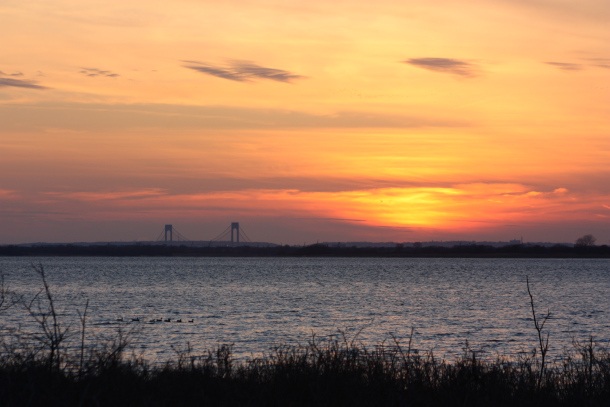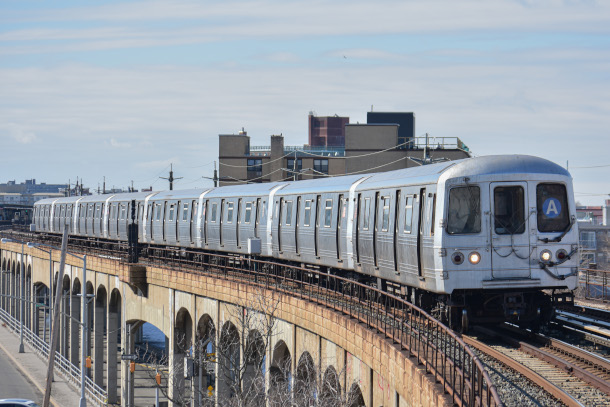Taking the A Train to a National Park
Air Date: Week of June 3, 2022

Jamaica Bay Wildlife Refuge in Gateway National Recreation Area. (Photo: Peter Roan, Flickr, CC BY-NC 2.0)
Gateway National Recreation Area offers green spaces, beaches and recreation just a quick transit ride from the urban jungle of New York City. Don Riepe is the guardian of the Jamaica Bay portion of Gateway and joins Host Steve Curwood to talk about the value of affordable and accessible venues in nature.
Transcript
CURWOOD: It’s that time of year when some people start hitting the road to the US National Parks for fun, sun and the blessings of nature. But in many places including New York City you don’t need to have a car and buy pricey gas to be in nature, as transit fare is enough. Gateway National Recreation Area spans across three boroughs of New York City and stretches out to Monmouth County, New Jersey. Since 1972, this land, managed by the National Park Service, has offered green spaces, beaches and recreational opportunities to residents of the nearby urban jungle. So, there’s the Jamaica Bay Wildlife Refuge in Brooklyn and Queens, Great Kills Park on Staten Island with swimming, boating, and hiking, and Sandy Hook with seven beaches on the New Jersey side. Don Riepe has been the Jamaica Bay Guardian since 2004 and he says one choice to get to the Bay on transit is to take….
RIEPE: The A train or you can even take the Q 53 bus to Rockaway and get off right at the entrance area. Another way to get here from Manhattan is to take the ferry from Wall Street to Rockaway at 108th Street, and that's right on the edge of the bay. And from there, you can take a short bus ride to the Refuge Visitor Center.
CURWOOD: Don, you can tell me what's your favorite part of the Gateway National Recreation Area, where if you really want to impress people as to how wonderful it is to have this National Park Service area right within reach of Brooklyn and Queens and Manhattan and Staten Island and the Jersey Shore. What's your favorite spot to show people where we're talking about?
RIEPE: Well, of course, it's the Jamaica Bay Wildlife Refuge. I lead tours there every month. In fact, this Saturday we're having a Horseshoe Crab Festival at 11 o'clock, and we do invite families, especially with children to come. It's a great event.
CURWOOD: I understand that along the beaches there this time of year, you're likely to run into horseshoe crabs.
RIEPE: Correct. Especially during the new moon or the full moon. Thousands of horseshoe crabs come ashore, as they've been doing for hundreds of thousands of years to lay their eggs. The big females come ashore and they burrow down just outside of the high tide area. And they lay big clutches of little greenish blue eggs and attending them are males. When she lays the eggs she gives off a pheromone, like a perfume, that stimulates the males to deposit sperm and fertilize them. We can pick up the crabs, we can show, turn them over and show the kids that they're harmless, show the difference between the male and the female and then we talk about their ecological and medical value. They have great medical value as well, because they're bluish copper based blood has a clotting factor in it that will clot when exposed to minute traces of pathogens, more sensitive than any instrument we have. And if you're getting a vaccination or a blood transfusion, you want it to be pure. They test it with that element from the horseshoe crab. So, who knew right?

Several public transportation options will bring you to Gateway National Recreation Area, including the A Train. (Photo: MTAEnthusiast10, Wikimedia Commons, CC BY-SA 4.0)
CURWOOD: Who knew? I mean, those creatures date back literally millions of years.
RIEPE: Yes, some people say as much as 400 million years back in the fossil records. They predate the dinosaurs actually.
CURWOOD: So, what am I going to see when I get there? What, if it's a National Recreation Area, how am I going to have recreation?
RIEPE: Well there are two ponds on either side of Cross Bay Boulevard. One is about 45 acres and the other is over 100 acres. And there's trails around them. And you'll see lots of waterbirds: egrets, herons, ibis, shorebirds, terns, all the birds of Jamaica Bay.
CURWOOD: An important neighbor of Gateway National Recreation Area is a major airport.
RIEPE: Correct.
CURWOOD: The Kennedy Airport.
RIEPE: Exactly.
CURWOOD: So some might say that there are a lot of metal birds as well as those with feathers.
RIEPE: Correct.
CURWOOD: So, how do you get the two to coexist?
RIEPE: It's not easy. So, at the airport, the U.S. Department of Agriculture has biologists that patrol the runway, and they will scare off any birds that are on the runway. If a pilot is taking off, and he sees something on the runway he calls it in and they do a, you know, patrol and they scare anything away. But they also have a shooting program. So they have permits from both the Fish and Wildlife Service and the New York State DEC to shoot any offending gulls or geese or whatever that come across airspace that they feel is a threat to aircraft.

Lucky visitors can spot horseshoe crabs on the beaches of Gateway. (Photo: Steve Curwood)
CURWOOD: What kind of creatures are in the water?
RIEPE: So we have over 100 species of finfish that have been identified in the bay. A lot of them are fish that people know that we eat like striped bass and black fish and blue fish and flounders and so on.
CURWOOD: So wait, can I take a rod and reel and go out and try to catch something?
RIEPE: Sure, fishing is allowed. A shout out to the New York City Department of Environmental Protection for upgrading the treatment plants. So that also made the water cleaner here.
CURWOOD: In other words, if you fall in, you don't have to quickly run and take a shower.
RIEPE: Not quickly, but eventually. And you know, you can just go offshore, you can take a boat out of Sheepshead Bay and see whales right off our coast here now, something you couldn't do 30 years ago. And I see seals in Jamaica Bay now in the winter and dolphins as well. So not only the waters are cleaner, but there's a lot more fish in the water that attract these large mammals.
CURWOOD: Now what about you know, a beach where you could put out a towel and go for a splash?
RIEPE: Yes, that would be at Riis Park. So Riis Park is also just over the Marine Park Bridge on the Rockaway side. And it's near the communities of Neponsit and Breezy Point. And those big beautiful beaches are open year round for people for recreation. And if you're in Brooklyn and Queens, you can go to different areas around Jamaica Bay like Plumb Beach, or Canarsie Pier if you want to fish, or Jamaica Bay Refuge if you want some passive recreation and birding and just enjoying the great views that we have here.
CURWOOD: Don, before you go tell me how important it is to have a National Recreation Area right within a subway or bus ride or boat ride of a major city like New York.
RIEPE: Well, you think of 8 million people broiling today in the city with all this heat looking for some outlet, and certainly going to the water is one of the best ways. So getting out to one of the local beaches or parks around there. You know, New York City Parks has a pretty good park system as well, as does Gateway. There are many different aspects to Gateway. If you're on Staten Island, there's Miller Field, which is a kind of big recreational field, and Great Kills Harbor. If you're in Sandy Hook, there's Sandy Hook National Seashore. So, these are all old military bases. So, they have historic value as well.
CURWOOD: And affordable, not necessarily places along say Central Park or Prospect Park, where the rents are a little higher these days.
RIEPE: Correct. And the mission of the Park Service, why they created Gateway, was to bring the parks to the people. For people that couldn't afford to go to Yellowstone or Yosemite or the Grand Canyon, at least they have a local place they can go and have the park experience as well.
CURWOOD: Don Riepe is the Jamaica Bay Guardian speaking to us about the Gateway National Recreation Area there in the New York New Jersey area. Thanks so much, Don for taking the time.
RIEPE: Thank you, it was fun.
Links
Living on Earth wants to hear from you!
Living on Earth
62 Calef Highway, Suite 212
Lee, NH 03861
Telephone: 617-287-4121
E-mail: comments@loe.org
Newsletter [Click here]
Donate to Living on Earth!
Living on Earth is an independent media program and relies entirely on contributions from listeners and institutions supporting public service. Please donate now to preserve an independent environmental voice.
NewsletterLiving on Earth offers a weekly delivery of the show's rundown to your mailbox. Sign up for our newsletter today!
 Sailors For The Sea: Be the change you want to sea.
Sailors For The Sea: Be the change you want to sea.
 The Grantham Foundation for the Protection of the Environment: Committed to protecting and improving the health of the global environment.
The Grantham Foundation for the Protection of the Environment: Committed to protecting and improving the health of the global environment.
 Contribute to Living on Earth and receive, as our gift to you, an archival print of one of Mark Seth Lender's extraordinary wildlife photographs. Follow the link to see Mark's current collection of photographs.
Contribute to Living on Earth and receive, as our gift to you, an archival print of one of Mark Seth Lender's extraordinary wildlife photographs. Follow the link to see Mark's current collection of photographs.
 Buy a signed copy of Mark Seth Lender's book Smeagull the Seagull & support Living on Earth
Buy a signed copy of Mark Seth Lender's book Smeagull the Seagull & support Living on Earth

